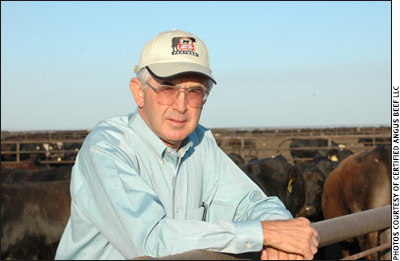
The Lobster Tail of Meats
Consumers have options, so put the best beef forward.
The growing beef supply won’t automatically find more room in the meatcase, but it can earn its way with differentiated quality.
“We can’t be as efficient in production as pork and poultry, so therefore we’re not going to be as cheap,” said Sam Hands, managing partner of Triangle H, Garden City, Kan. “We know that.”
Addressing producers at Cattlemen’s College® last February in Nashville, Tenn., he said, “If we were gearing up for a party and wanted fish, we’d be thinking about lobster tail, because that’s the ultimate goal. At the meat counter, we are the lobster tail, so we have to make sure we’re the best.”

Addressing producers at Cattlemen’s College last February in Nashville, Tenn., Sam Hands said, “If we were gearing up for a party and wanted fish, we’d be thinking about lobster tail, because that’s the ultimate goal. At the meat counter, we are the lobster tail, so we have to make sure we’re the best.”
That’s within reach for beef, thanks to genetics that lifted cattle above load-lot anonymity, back when “there was no discrimination, no difference between good and bad.”
Grid marketing created incentives so that now 75% of cattle grade Choice or better, ratcheting the entry level for premiums to even higher levels.
“Pounds pay the bills, but what sets your cattle apart?” Hands asked. “Quality makes the difference in most grid scenarios.”
He knows from experience with the integrated Triangle H farm, feedyard and commercial Angus herd.
“Genetically, the cattle can do it,” he said. “We see it in our own feedlot and with our customers’ cattle. At harvest, we want to be sure to realize all the potential market that is there.”
At the same time, Hands encourages steady progress in every herd supplying calves for feeding so they are worth a premium at every step.
“We want our customers to continue to make genetic improvements,” he said. “We know the tools are there to help them get there.”
Tools such as genomic testing and predictive databases have advanced to support those choices. That’s good for everyone involved — even those scanning the meat counter.
“These cattle have to work on the ranch back home,” Hands said, “but we have to make sure that our consumers, when they sit down at home, go out to a restaurant or relax with a picnic, that they have the best eating experience they can imagine.”
LeAnne Saunders, president of Where Food Comes From Inc., a leader in certification and verification services, also on that “value-added” panel, noted 84% of consumers say they will pay 5% more for brands.

For those who would differentiate their cattle, Saunders suggested anticipating and getting ahead of the next trend’s curve.
Hitting the mark for any brand that pays cattle producers must start long before harvest.
“In a segmented supply chain, we have to know what they (consumers) want in order to deliver,” she said, because “they can buy something else.”
What they want goes well beyond price, packaging and color of product, Saunders said, all the way to “credence attributes” as they read those labels.
“It’s something that can’t necessarily be determined with the naked eye,” she said. “It’s how the animal was treated, its environmental impact, how their food was grown and how it got here.”
For those who would differentiate their cattle, Saunders suggested anticipating and getting ahead of the next trend’s curve.
“The opportunity is greater than the expense going in,” she said of programs such as non-hormone treated cattle (NHTC) and age and source verification, which her company offers.
“Through years of collecting the premium data on feeder cattle, we know there are opportunities in these markets, and consumers are paying for these specific attributes,” Saunders said. Producer participation starts with keeping records and choosing a program.
“Not all programs fit everybody,” she said. “The great opportunity we have in the beef industry today is that the consumer wants choices. They want transparency, and they want information. There isn’t one size fits all.”
Hands and Saunders agreed that starting with high-quality beef provides the most opportunity.

Editor’s Note: Laura Conaway is producer communications specialist for Certified Angus Beef LLC.






